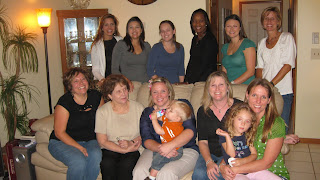As we have been moving through our unit on Native Americans, the children have been working on reports about their Native tribes. Most kinder classes began with reports about themselves at the beginning of the nine weeks because there is nothing kindergartners know more about than themselves! During Readers' Workshop the children have been reading and investigating nonfiction text and learning about nonfiction text features such as titles, chapter headings, labels, Table of Contents, etc. The expectation is that children will begin to use these text features as they write their reports.
As the children were beginning to write about their tribes, they had many experiences to build their background knowledge. Each class studied the types of houses the Natives lived in and then built replicas of those houses with their families during Family Night. They learned about what their tribes wore and then helped to dress a cardboard cutout in tribal gear. They also made many of the pieces that they wore during the Pow Wow. The Nootkas learned, for instance, that the spears that they made were used to spear whales. The Seminoles learned that the ribbons they made were used for ceremonial dances. The children learned what the Natives ate and then tasted some of the foods during the Pow Wow activities. Throughout the activities, the stories that they read and the research that they did, each child learned so much that they could write about!
Teachers depend on our Kindergarten Native American wiki for the research about their tribes. The information is continually updated by each teacher each year that teaches the tribe. It saves teachers an enormous amount of time!
As the children were beginning to write about their tribes, they had many experiences to build their background knowledge. Each class studied the types of houses the Natives lived in and then built replicas of those houses with their families during Family Night. They learned about what their tribes wore and then helped to dress a cardboard cutout in tribal gear. They also made many of the pieces that they wore during the Pow Wow. The Nootkas learned, for instance, that the spears that they made were used to spear whales. The Seminoles learned that the ribbons they made were used for ceremonial dances. The children learned what the Natives ate and then tasted some of the foods during the Pow Wow activities. Throughout the activities, the stories that they read and the research that they did, each child learned so much that they could write about!
Teachers depend on our Kindergarten Native American wiki for the research about their tribes. The information is continually updated by each teacher each year that teaches the tribe. It saves teachers an enormous amount of time!
Below is just one example of a kindergartner's writing from Miss Sasso's Hopi tribe. Nate has a title for his book, Nate's The Hopi Book.



Miss Sasso gave each child a form to help them organize a Table of Contents. Nate's Table of Contents includes:
1. What did the Hopi eat? 1
1. What did the Hopi eat? 1
2. What did the Hopi wear? 2
3. Where did the Hopi (live)? 3
4. How did the Hopi travel? 4
5. Snake Dances 5

Nate begins each chapter with a question. Notice also how he uses labels and in this chapter, a list.
What did the Hopi eat?
red beans
yellow orn
rabbits
deer
 What did the Hopi wear?
What did the Hopi wear?
Girls wear mantas and boys wear kilts.

Where did the Hopi live?
Indians lived in Arizona and adobe. To get up to the top they needed a ladder and windows.

How did the Hopi travel?
The Hopis walk in feet.

Snake Dances
The Hopis need snakes for the Snake Dances.

.jpg)













 Susanne Shall
Susanne Shall







